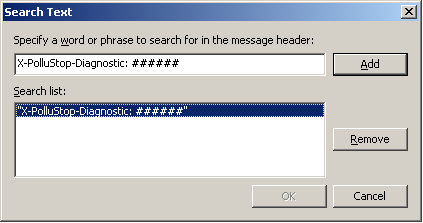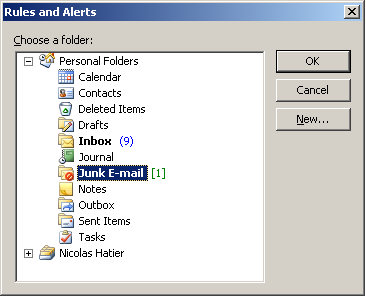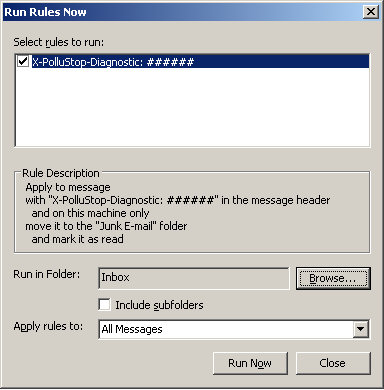PolluStop will always add a header to all messages it processes, and this header can be used to sort mail in a separate folder. When setup for POP users, PolluStop can also (optionally) tag subject of spam messages with [SPAM]. Desktop e-mail clients should be configured to sort these messages into a separate folder. Some clients are able to process the PolluStop header, some others will have to use the [SPAM] tag.
Setup Outlook to automatically sort spam-tagged emails into a separate folder
In Outlook, what we are going to do is called making a Rule, it may be called something else in other programs.
Outlook usually creates a Junk E-mail folder automatically, we are going to use it to store the mail we will filter.
Pull the Tools menu to Rules and Alerts.
In the Rules and Alerts Window, click on the New Rule... button. Select Start from a blank rule.
Select Check messages when they arrive and click Next.
Put a check mark at with specific words in the message header.
In rule description box, click on specific words.
Specify "X-PolluStop-Diagnostic: ######" in the box and click Add. Click Ok, then Next.
Put a check mark at move it to the specified folder, and at mark it as read. The spam shoud be marked as read so the Junk E-mail mailbox won't be displayed in bold. After all, we want Spam filtered out, so it won't annoy us.
In rule description box, click on specified.
Select the Junk E-mail folder in the window that appears. Click Ok, then Next.
Click Next again.
Specify a name for the rule (the actual name might be Ok but confusing). Click Finish. Your rule should now look like this:
Ok, so if we got everything right, all future Spam messages will to be automatically filed in the Junk E-mail folder. But what about all the messages that are already cluttering our Inbox? Let's get those spam messages into the Junk E-mail folder right now as well.
Click on the Run Rules Now button, put a checkmark near the name of the rule you just created, click on Browse to select your Inbox, and click on Run Now. You can now click on Close, then Ok
All the tagged Spam messages are now in their Junk Mail folder. From now on, they will jump in there themselves.
Use Outlook to forward messages as attachments
Outlook can be configured to automatically forward messages as attachments. It's usually a good idea to forward all messages as attachments since it keeps the original message unchanged.
- Open Outlook's Options window by pulling down the Tools menu to Options.
- Click on the E-mail options button.
- Make sure the "When forwarding a message" option, about halfway down the window, is set to "Attach original message" Click on OK twice.
- Et voilą! Next time you will forward a message, it will be forwarded as attachment. When you forward one to PolluStop, it will be able to extract the original header information to train itself properly and to whitelist the sender if it was a good message.




